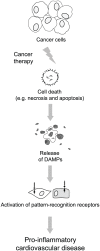Out of the frying pan and into the fire: damage-associated molecular patterns and cardiovascular toxicity following cancer therapy
- PMID: 28911261
- PMCID: PMC5933669
- DOI: 10.1177/1753944717729141
Out of the frying pan and into the fire: damage-associated molecular patterns and cardiovascular toxicity following cancer therapy
Abstract
Cardio-oncology is a new and rapidly expanding field that merges cancer and cardiovascular disease. Cardiovascular disease is an omnipresent side effect of cancer therapy; in fact, it is the second leading cause of death in cancer survivors after recurrent cancer. It has been well documented that many cancer chemotherapeutic agents cause cardiovascular toxicity. Nonetheless, the underlying cause of cancer therapy-induced cardiovascular toxicity is largely unknown. In this review, we discuss the potential role of damage-associated molecular patterns (DAMPs) as an underlying contributor to cancer therapy-induced cardiovascular toxicity. With an increasing number of cancer patients, as well as extended life expectancy, understanding the mechanisms underlying cancer therapy-induced cardiovascular disease is of the utmost importance to ensure that cancer is the only disease burden that cancer survivors have to endure.
Keywords: cancer therapy; cardio-oncology; cardiotoxicity; cardiovascular disease; damage-associated molecular patterns; inflammation.
Conflict of interest statement
Figures



Similar articles
-
Multi-Modality Imaging in the Assessment of Cardiovascular Toxicity in the Cancer Patient.JACC Cardiovasc Imaging. 2018 Aug;11(8):1173-1186. doi: 10.1016/j.jcmg.2018.06.003. JACC Cardiovasc Imaging. 2018. PMID: 30092972 Review.
-
The Burgeoning Field of Cardio-Oncology.Methodist Debakey Cardiovasc J. 2019 Oct-Dec;15(4):241-242. doi: 10.14797/mdcj-15-4-241. Methodist Debakey Cardiovasc J. 2019. PMID: 31988683 Free PMC article. No abstract available.
-
Imaging in Cardio-Oncology: Where Are We and Where Should We Be Going?JACC Cardiovasc Imaging. 2018 Aug;11(8):1209-1211. doi: 10.1016/j.jcmg.2018.07.001. JACC Cardiovasc Imaging. 2018. PMID: 30092977 No abstract available.
-
Future Directions in Cardio-Oncology.Methodist Debakey Cardiovasc J. 2019 Oct-Dec;15(4):300-302. doi: 10.14797/mdcj-15-4-300. Methodist Debakey Cardiovasc J. 2019. PMID: 31988691 Free PMC article. Review. No abstract available.
-
Cardio-Oncology: An Update on Cardiotoxicity of Cancer-Related Treatment.Circ Res. 2016 Mar 18;118(6):1008-20. doi: 10.1161/CIRCRESAHA.115.303633. Circ Res. 2016. PMID: 26987914 Review.
Cited by
-
TLR4-A Pertinent Player in Radiation-Induced Heart Disease?Genes (Basel). 2023 Apr 28;14(5):1002. doi: 10.3390/genes14051002. Genes (Basel). 2023. PMID: 37239362 Free PMC article. Review.
-
Emerging mitochondrial signaling mechanisms in cardio-oncology: beyond oxidative stress.Am J Physiol Heart Circ Physiol. 2022 Oct 1;323(4):H702-H720. doi: 10.1152/ajpheart.00231.2022. Epub 2022 Aug 5. Am J Physiol Heart Circ Physiol. 2022. PMID: 35930448 Free PMC article. Review.
-
Curcumin in Osteosarcoma Therapy: Combining With Immunotherapy, Chemotherapeutics, Bone Tissue Engineering Materials and Potential Synergism With Photodynamic Therapy.Front Oncol. 2021 May 20;11:672490. doi: 10.3389/fonc.2021.672490. eCollection 2021. Front Oncol. 2021. PMID: 34094974 Free PMC article. Review.
-
Emerging Challenges of Radiation-Associated Cardiovascular Dysfunction (RACVD) in Modern Radiation Oncology: Clinical Practice, Bench Investigation, and Multidisciplinary Care.Front Cardiovasc Med. 2020 Feb 21;7:16. doi: 10.3389/fcvm.2020.00016. eCollection 2020. Front Cardiovasc Med. 2020. PMID: 32154267 Free PMC article. Review.
-
Heart Inflammation: Immune Cell Roles and Roads to the Heart.Am J Pathol. 2019 Aug;189(8):1482-1494. doi: 10.1016/j.ajpath.2019.04.009. Epub 2019 May 18. Am J Pathol. 2019. PMID: 31108102 Free PMC article. Review.
References
-
- American Cancer Society. Cancer treatment and survivorship: facts and figures 2016-2017. Atlanta 2016, https://www.cancer.gov/publications/dictionaries/cancer-terms?CdrID=44004.
-
- Wickramasinghe CD, Nguyen KL, Watson KE, et al. Concepts in cardio-oncology: definitions, mechanisms, diagnosis and treatment strategies of cancer therapy-induced cardiotoxicity. Future Oncol 2016; 12: 855–870. - PubMed
-
- Okwuosa TM, Anzevino S, Rao R. Cardiovascular disease in cancer survivors. Postgrad Med J 2017; 93: 82–90. - PubMed
Publication types
MeSH terms
Substances
Grants and funding
LinkOut - more resources
Full Text Sources
Other Literature Sources


